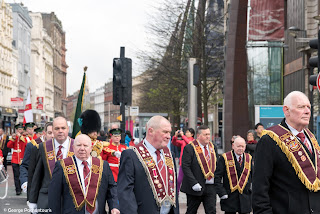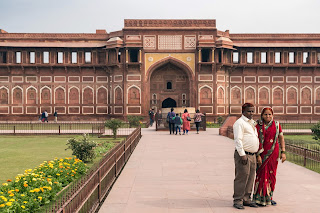Amsterdam to Maastricht by bicycle
The Netherlands is a cycling paradise. Mainly because of the completely flat terrain, the Dutch are using the bicycle both as a recreation activity but also as the main means of every day transportation. Amsterdam, the capital is full of cyclists who go to their daily jobs almost exclusively by bicycle. The extensive and safe bicycle lane network also helps.
What is surprising, is that the same well maintained and comprehensive network exists all over the country. It is possible to cycle from any part of the country to any other part exclusively by bicycle and using multiple different routes!
The way how this works is with a set of numbered points. Every stretch of cycling path starts and ends to a numbered point. Several paths may start and end to a point, similar to the screenshot to the right. So just by writing down the points of the planned route, one can easily travel anywhere.
On top of that, there is a network of 7 routes, all with their own labeling, for long distance routes. They are using the initials LF (ie. LF7) and the distances range from 165 to 1300km! One of those routes is the one we decided to follow and starts from Alkmaar (few km north of Amsterdam) all the way to Maastricht in the very south of the country.
Amsterdam to Maastricht by bicycle
We followed the route LF7a (LF7b is the other way around, Maastricht to Alkmaar) which is 385km in total. The part from Amsterdam to Maastricht following this route is 317km long and we completed it in 4 days. We did not have any special racing bikes, just normal city bikes so we took it easy, enjoying the countryside. The route can be easily completed in 3 days and with racing bike in 2 but then half of the fun of enjoying the Netherlands is lost. We found that a few signs were missing but in a route of 317km and a few thousand turns, it sounds almost normal. When feeling lost, we checked the map on the mobile phone and quickly found the correct way.
It is a beautiful way to experience the Netherlands. The route took us through places that no car can go and within 317km we could experience the changing Dutch landscape, both in terms or architecture and nature. The route is themed "Oeverlandroute" literally meaning River Bank route and the truth is that we crossed and were almost always next to rivers. It was quite fun crossing some of them by ferries and not so much fun missing the last ferry after a long day of cycling.
Apart from the rivers, the route took us right through major Dutch cities like Utrecht, Den Bosch and Eindhoven but also beautiful tiny villages like Thorn in Limburg, Heusden in North Brabandt and Vreeland in Utrecht province. For the last part of the route, cycling next to river Maas, was almost exclusively in Belgium so we even got to cycle on a different country. And we also got to find some details of the Netherlands that go completely unnoticed, like some beach resort complete with beach bars, water activities, slides etc in Limburg or a village somewhere outside Eindhoven where transportation seemed to be done exclusively with Indian style tuc-tucs! We also used a ferry to cross one of the rivers that the ticket collector did not have enough time from one side to the other to sell all tickets so the captain technically delayed landing on the other side.. Many details like that made the trip a nice experience.
At nights we stayed in beautiful B&B's of which the Netherlands is full of. And all of them come with parking facilities for bicycles! If you plan to follow that route, it is probably wise to book in advance so you are sure you will find a place to stay. Might be tricky during holidays in the Netherlands.
The experience was amazing and highly recommended. It is not as difficult as it may sound but having a good bicycle is essential. It does not have to be fast or anything, just reliable. The path is in excellent shape and very well maintained. Cafes, restaurants and super markets are in abundance along the way. A piece of advice if you plan to take the route is to take it easy and enjoy it. By planning to cycle around 80km per day, the route can be completed in 4 days which is a good enough pace. Oh, and also try to factor in the weather, which is almost impossible planning such a trip in advance. Still, be prepared for all kinds of weather at any season of the year :-)
Sources
Cycling in the Netherlands: https://en.wikipedia.org/wiki/Cycling_in_the_Netherlands
Long distance routes: http://www.hollandcyclingroutes.com/long-distance-cycle-routes/oeverlandroute
The Netherlands is a cycling paradise. Mainly because of the completely flat terrain, the Dutch are using the bicycle both as a recreation activity but also as the main means of every day transportation. Amsterdam, the capital is full of cyclists who go to their daily jobs almost exclusively by bicycle. The extensive and safe bicycle lane network also helps.
What is surprising, is that the same well maintained and comprehensive network exists all over the country. It is possible to cycle from any part of the country to any other part exclusively by bicycle and using multiple different routes!
The way how this works is with a set of numbered points. Every stretch of cycling path starts and ends to a numbered point. Several paths may start and end to a point, similar to the screenshot to the right. So just by writing down the points of the planned route, one can easily travel anywhere.
On top of that, there is a network of 7 routes, all with their own labeling, for long distance routes. They are using the initials LF (ie. LF7) and the distances range from 165 to 1300km! One of those routes is the one we decided to follow and starts from Alkmaar (few km north of Amsterdam) all the way to Maastricht in the very south of the country.
Amsterdam to Maastricht by bicycle
 |
| Comprehensive signpost |
It is a beautiful way to experience the Netherlands. The route took us through places that no car can go and within 317km we could experience the changing Dutch landscape, both in terms or architecture and nature. The route is themed "Oeverlandroute" literally meaning River Bank route and the truth is that we crossed and were almost always next to rivers. It was quite fun crossing some of them by ferries and not so much fun missing the last ferry after a long day of cycling.
 |
| Along the river Vecht |
 |
| In Belgium! |
The experience was amazing and highly recommended. It is not as difficult as it may sound but having a good bicycle is essential. It does not have to be fast or anything, just reliable. The path is in excellent shape and very well maintained. Cafes, restaurants and super markets are in abundance along the way. A piece of advice if you plan to take the route is to take it easy and enjoy it. By planning to cycle around 80km per day, the route can be completed in 4 days which is a good enough pace. Oh, and also try to factor in the weather, which is almost impossible planning such a trip in advance. Still, be prepared for all kinds of weather at any season of the year :-)
Complete route as registered on a GPX file
Sources
Cycling in the Netherlands: https://en.wikipedia.org/wiki/Cycling_in_the_Netherlands
Long distance routes: http://www.hollandcyclingroutes.com/long-distance-cycle-routes/oeverlandroute




















































